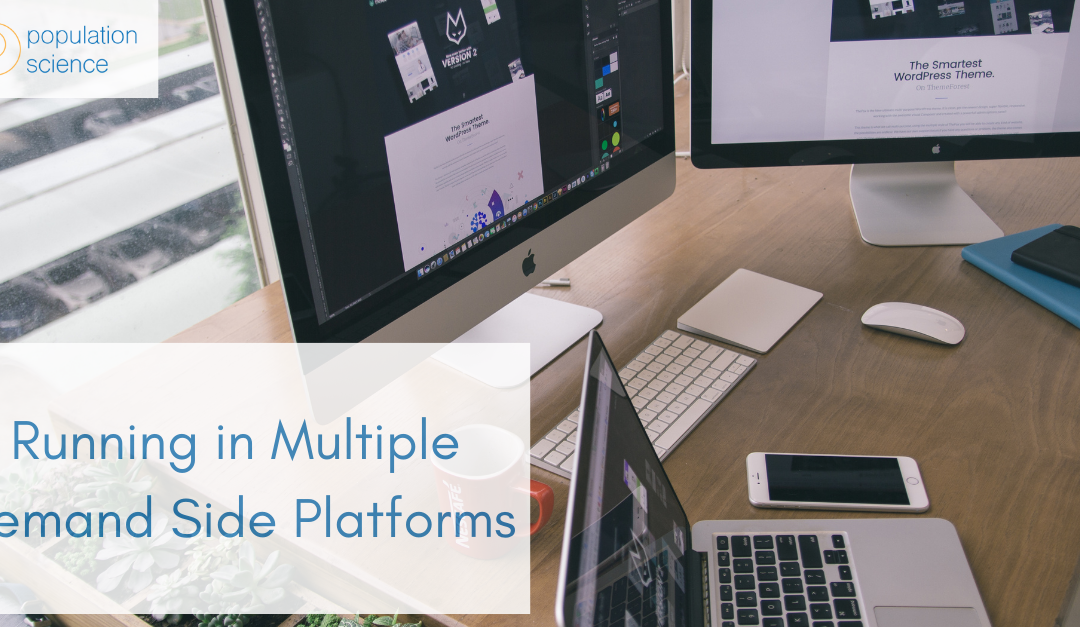
by Johnathan Barnes | Nov 17, 2023 | Digital Marketing, Programmatic
Running ads efficiently on more than one Demand Side Platform (DSP) requires a strategic approach that optimizes time, resources, and budget while maximizing reach and performance. Here are several best practices to consider when running in multiple demand side platforms:
Use a Data Management Platform (DMP)
Integrating a DMP can help you centralize and manage your data across different DSPs. This allows for consistent audience segmentation and targeting, and helps in making data-driven decisions across platforms.
Establish Clear Objectives and KPIs
Define what you’re trying to achieve with your campaigns and the metrics you’ll use to measure success. Why are you using multiple DSPs to achieve your goals? It’s likely you are cherry picking best of breed in channel partnerships or you need access to owned and operated (O&O) inventory available on only one platform. For example, an ecommerce brand may need Amazon DSP to access premium data and inventory within the Amazon ecosystem, but also needs a best of breed solution to reach their target audience across a variety of top connected TV apps outside of the Amazon ecosystem. Consistent KPIs across DSPs will help you compare performance effectively. For more information on implementing a DSP, check out this article: https://populationscience.com/how-to-implement-a-demand-side-platform-dsp/
Standardize Creative Assets
Prepare a set of creative assets that can be used across all platforms. This includes ad copy, images, videos, and interactive elements that are in line with the specifications of each DSP. If you deviate too far from the standard it can be difficult to understand if the DSP or the creative that is used is the issue if you experience poor performance.
Automate Where Possible
Use automation tools within the DSPs for bidding, optimization, and reporting. Many DSPs offer automated rules and machine learning algorithms to adjust campaigns in real-time based on performance.
Central Reporting Dashboard
Consider using or building a central reporting dashboard that can pull in data from all the DSPs you are using. This allows for an aggregated view of performance and simplifies the analysis process.
Balance Overlapping and Unique Targeting
Be mindful of audience overlap across DSPs to avoid bidding against yourself. However, leverage the unique data or inventory sources of each DSP to reach different segments of your audience. If you have established clear objectives for why you are using multiple DSPs you should be able to avoid overlap in bidding on inventory.
Optimize Based on Performance
Regularly review campaign performance across all DSPs and shift budgets to the platforms and campaigns that are performing the best.
Work with a Media Aggregator
For smaller businesses or those without the capacity to manage multiple DSPs, consider working with a media aggregator or an agency that can manage this for you. They have the expertise and technology to run campaigns across multiple platforms efficiently.
Leverage Cross-DSP Strategies
Some strategies may be more effective on certain DSPs due to their specific strengths or inventory. Tailor your approach to each platform while maintaining a cohesive overall strategy.
By carefully planning and continuously optimizing, you can efficiently run ads across multiple DSPs and achieve better results from your advertising spend.

by Johnathan Barnes | Nov 17, 2023 | Digital Marketing, Programmatic
A Demand Side Platform (DSP) determines what to bid for each ad impression using a complex process that takes into account several factors. Here’s a simplified breakdown of how this works:
Advertiser Input
– Campaign Objectives: The DSP considers the goals of the campaign, whether it’s brand awareness, lead generation, conversions, etc.
– Budget: The advertiser sets the campaign budget and bid limits.
– Bid: The advertiser sets the maximum CPM or CPC they are willing to pay.
– Targeting Criteria: The advertiser defines the audience segments, geolocations, devices, and other targeting parameters.
– KPIs: Key performance indicators are set, which can include click-through rate (CTR), conversion rate, cost per acquisition (CPA), etc.
If you’re looking to learn more on how to implement a DSP, check out this article here: https://populationscience.com/how-to-implement-a-demand-side-platform-dsp/
Data Analysis
– Audience Data: The DSP uses first-party data (from the advertiser), third-party data (from external providers), and its own data to identify the value of a potential impression.
– Historical Performance: Past performance data of similar ads and targeting criteria are used to predict future performance.
– Contextual Data: Information about the content surrounding the ad placement is considered to ensure relevance and brand safety.
Real-Time Bidding (RTB) Auction Mechanics
– Auction Type: The DSP evaluates whether the auction is a first-price (pay the price you bid) or second-price auction (pay one penny over the second place bidder), which impacts how much should be bid.
– Supply and Demand: The DSP assesses the supply of available impressions and the demand from other advertisers, which influences the market price.
– Bidstream Data: Each bid request contains data such as user demographics, behaviors, the site/app they’re on, and other key data points which the DSP uses to calculate the value of the impression and whether or not it meets your inputs. For more information about the bidstream click here (link to our other blog)
Machine Learning and Algorithms
– Predictive Modeling: DSPs employ machine learning algorithms to predict the likelihood of a user taking the desired action after seeing an ad.
– Bid Optimization Algorithms: These algorithms determine the optimal bid amount based on the likelihood of meeting the campaign’s objectives at the lowest possible cost. Note, some DSPs allow you to customize your own bidding algorithm.
Budget Optimization
– Pacing: The DSP ensures the budget is spent evenly over the campaign duration or adjusts spending based on performance peaks and lulls.
– ROI Considerations: The DSP will bid higher for impressions that are more likely to lead to a conversion or achieve the desired outcome, ensuring a better return on investment.
Real-Time Decisioning
– Latency Constraints: DSPs have milliseconds to make a bid decision once they receive a bid request.
– Dynamic Bidding: The actual bid is dynamically calculated in real-time for each impression, based on all the above factors.
Feedback Loop
– Performance Feedback: After the ad is served, the DSP collects performance data which is fed back into the system to refine future bidding strategies.
Conclusion
The DSP’s bidding process is a sophisticated, real-time system that combines advertiser-defined parameters with advanced data analytics and machine learning to calculate the most appropriate bid for each ad impression. It’s designed to maximize the chances of achieving the advertiser’s goals while optimizing the use of the campaign budget. The process is highly automated and occurs in the time it takes for a webpage or app to load.

by Johnathan Barnes | Nov 16, 2023 | Digital Marketing, Programmatic
A Demand Side Platform (DSP) is a sophisticated piece of advertising technology that automates the purchase and management of digital ad campaigns across multiple sources of inventory. DSPs are designed to streamline the digital advertising process for advertisers, agencies, and media buyers. Here are the core functions of a demand side platform:
Centralized Ad Buying
DSPs connect to various ad exchanges, networks, and supply-side platforms (SSPs), allowing buyers to purchase from a large pool of inventory through a single interface.
Real-Time Bidding (RTB)
DSPs facilitate RTB, which allows advertisers to bid on ad inventory in real-time, often within milliseconds, as a webpage or app is loading.
Targeting
– Audience Targeting: Advertisers can target specific audience segments based on demographics, interests, behaviors, geolocation, device type, and more.
– Contextual Targeting: Allows targeting based on the content of the website or app where the ad will be displayed.
– Retargeting: Enables advertisers to target users who have previously interacted with their brand but did not convert.
Data Integration
– First-Party Data: DSPs can integrate with an advertiser’s first-party data for more personalized targeting.
– Third-Party Data: They often provide access to third-party data providers for additional targeting capabilities (be sure to vet these 3rd parties before use).
Campaign Management
– Ad Scheduling: Advertisers can schedule when ads will appear (dayparting).
– Frequency Capping: Limits how often a specific user sees an ad over a set period.
– Budget Management: Control over campaign budgets and the ability to set bid prices.
Creative Management
– Ad Creative Upload: Upload and manage different ad creatives directly within the platform.
– Dynamic Creative Optimization (DCO): Customizes creative elements in real-time based on the viewer’s profile.
Optimization and Automation
– Performance Optimization: Algorithms optimize bidding and placement for the best possible outcomes based on the campaign’s objectives.
– Machine Learning: Many DSPs use machine learning to improve campaign performance over time.
Analytics and Reporting
– Performance Tracking: DSPs provide detailed analytics on various aspects of campaign performance, such as impressions, clicks, conversions, and more.
– Custom Reporting: Advertisers can create customized reports to track specific KPIs.
Inventory and Pricing Transparency
– Clear Inventory Sources: Visibility into where ads could potentially run.
– Pricing Visibility: Understanding the cost associated with each impression or click.
Brand Safety and Fraud Prevention
– Brand Safety Tools: Options to prevent ads from appearing on inappropriate or low-quality sites.
– Fraud Detection: Measures to detect and prevent fraudulent impressions and clicks.
Integration with Other Platforms
– Cross-Platform Buying: Ability to buy ads across different types of digital media, including mobile, video, social media, and connected TV (CTV).
– APIs: Integration with external systems and third-party services via APIs.
Compliance and Privacy
– Regulatory Compliance: Features to ensure compliance with privacy laws like GDPR and CCPA.
– Consent Management: Tools to manage user consent for data usage and cookies.
Customer Support and Education
– Support Services: Assistance with campaign setup, optimization, and troubleshooting.
– Educational Resources: Training materials and best practices for using the platform effectively.
While most DSPs offer these functions, the depth and sophistication of these features can vary widely from platform to platform. It’s essential for advertisers to evaluate DSPs based on how well they meet their specific needs, budget, and technical capacity. If you want to read more about DSPs and Supply Side Platforms or SSPs, check out this article: https://populationscience.com/demand-side-platforms-and-supply-side-platforms-for-dummies/.

by Johnathan Barnes | Nov 16, 2023 | Digital Marketing, Programmatic
For small businesses looking to leverage a Demand Side Platform (DSP), the focus is typically on finding a solution that is cost-effective, user-friendly, and suitable for the scale of their operations. Here are some key factors that small businesses should consider when choosing a DSP:
Minimum Spend Requirements
Some DSPs have high minimum ad spend requirements, which can be a barrier for small businesses. Look for platforms with low or no minimum spends. If you are set on using a DSP with high miniums you might want to consider an agency that has a seat at the DSP of your choice. They will generally be more flexible on minimum spend requirements, but they will take an additional margin.
Managed Service vs. Self-Service
Most DSPs will provide a managed service for clients that do not have the internal resources or expertise to manage the operations of a DSP. This comes with an additional fee and varies by platform. Managed service is a good way to start out any programmatic journey, but if you’re willing to dive in and manage the DSP yourself (self-service) make sure the platform has a robust and easy to access help section.
Customer Support
Good customer service is crucial, as small businesses might not have dedicated ad operations teams. The DSP should offer strong support and educational resources. Be up front about your budget for a DSP and realistic about your ability to scale spend. If you plan to spend small, you want to make sure the DSP you choose is okay with that. Many DSPs provide relatively poor service to small spenders.
Targeting Capabilities
While advanced targeting features are beneficial, small businesses should ensure that the DSP offers the basic targeting options they need, such as geographic, audience, demographic, contextual, and interest-based targeting. For small local businesses geo-fencing is likely to be a critical feature you will need to ensure media is only spent on potential customers in your area.
Scalability
As the business grows, the DSP should be able to scale up with the business’s needs without requiring a platform switch.
It’s important for small business owners to diligently research and potentially test different DSPs to see which platform aligns best with their advertising goals and budget constraints. Many DSPs offer demo accounts or trial periods, which can be an excellent opportunity for businesses to experiment and learn without committing significant resources.
While these are issues that are specific to small businesses there are many more factors that can come into play when selecting the right DSP. For more on selecting the right DSP for your business check out our other resources on the topic: https://populationscience.com/demand-side-platform-buyer-guide/

by Johnathan Barnes | Nov 10, 2023 | Digital Marketing, Programmatic
Demand Side Platforms (DSPs) and Supply Side Platforms (SSPs) are two critical components in the programmatic advertising ecosystem, each serving opposite sides of the market.
Demand Side Platforms (DSPs)
DSPs are software platforms used by advertisers and agencies to purchase advertising space in an automated fashion. Here’s what they do:
– Automate Buying: DSPs automate the buying of online advertising, making it more efficient than traditional methods.
– Aggregate Inventory: They provide access to a vast array of digital advertising inventory from various sources, including ad exchanges, ad networks, and SSPs.
– Target and Bid: Advertisers can set detailed targeting criteria and bid for ad space in real-time based on the value of each impression.
– Optimize Campaigns: DSPs offer tools for tracking, analytics, and optimization to help advertisers improve the performance of their campaigns over time.
Supply Side Platforms (SSPs)
SSPs are the counterpart to DSPs, and they’re used by publishers to sell advertising space to advertisers. Here’s their role:
– Automate Selling: SSPs automate the sale of advertising space, maximizing revenue for publishers.
– Manage Inventory: They help publishers manage their ad inventory and fill rates.
– Maximize Revenue: Publishers can set floor prices for their inventory and use SSPs to connect to multiple ad exchanges and DSPs, ensuring they get the best possible price for each ad impression.
– Optimize Fill Rates: SSPs assist publishers in optimizing their fill rates (the percentage of ad inventory that is filled with ads) while still aiming to get the best prices.
The Difference
The fundamental difference between DSPs and SSPs lies in whom they serve and how they operate within the programmatic advertising supply chain:
– DSPs serve advertisers in their quest to find and purchase the best possible digital ad inventory at the most optimal price. They focus on the demand side of the market—those who need ad space.
– SSPs serve publishers who want to sell their digital ad space to the highest bidder. They focus on the supply side of the market—those who supply ad space.
In a programmatic advertising transaction, DSPs and SSPs interact with each other through ad exchanges, where the actual buying and selling of ad inventory take place in real-time bidding (RTB) auctions. The DSPs represent the buyers, and the SSPs represent the sellers. While they have distinct roles, both are integral to the efficiency and effectiveness of digital advertising.

by Johnathan Barnes | Nov 10, 2023 | Digital Marketing, Programmatic
Demand Side Platforms (DSPs) often offer various levels of customization to better meet the specific needs of advertisers and marketers. The extent and nature of these customizations can vary significantly from one DSP to another, but here are some common areas where you may be able to customize a DSP:
- Targeting Options
Advertisers can set up custom targeting parameters to reach specific audience segments based on demographics, interests, behaviors, location, and more. This can also include creating lookalike audiences or retargeting users based on their interactions with your brand.
- Bid Strategies
DSPs usually allow for customized bid strategies where advertisers can set their bidding rules based on the campaign goals. This can involve manual bid adjustments or setting up algorithmic bidding that automatically optimizes towards certain KPIs.
- Creative Optimization
Some DSPs offer dynamic creative optimization (DCO), which allows advertisers to customize and test different creative elements in real-time based on the audience or performance data.
- Data Integration
Many DSPs can integrate with external data sources, such as Data Management Platforms (DMPs), Customer Relationship Management (CRM) systems, and third-party data providers. This allows for the use of proprietary data for targeting and personalization.
- Reporting and Analytics
DSPs often provide customizable reporting dashboards where advertisers can choose which metrics to monitor and how they want to visualize their campaign performance data.
- Inventory and Exchange Access
Advertisers can generally choose which ad exchanges and inventory sources they want to utilize or exclude, which can be important for brand safety and quality control.
- API Access
For advanced customization, some DSPs offer API (Application Programming Interface) access, allowing advertisers to programmatically interact with the platform, automate processes, or integrate with in-house systems.
- Algorithm Customization
Another more advanced feature offered by some DSPs is the ability to customize the machine learning algorithms or attribution models to better suit their unique campaign goals and conversion paths.
Conclusion
Customization capabilities are a significant factor when selecting a DSP, as they can greatly enhance the effectiveness of digital advertising campaigns. However, the level of customization needed will depend on the complexity of the advertiser’s campaigns, their technical expertise, and specific marketing goals. It’s also essential to balance customization with usability—highly customizable platforms can become complex and may require more advanced knowledge to manage effectively.







